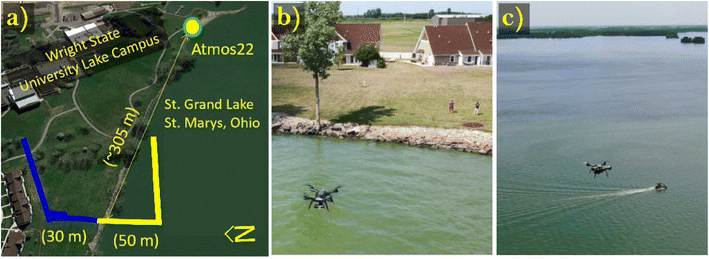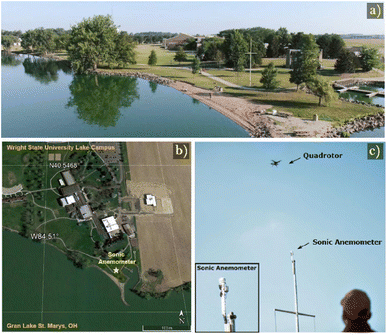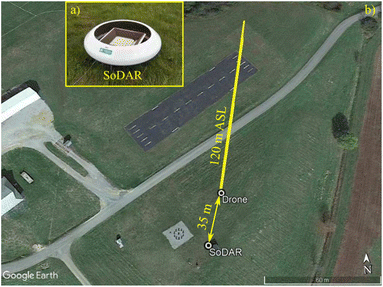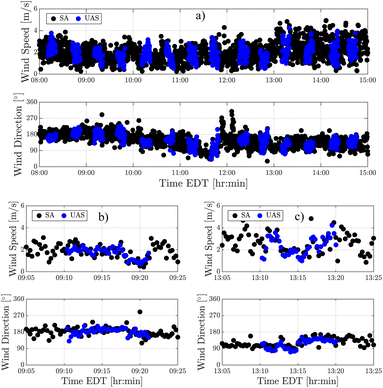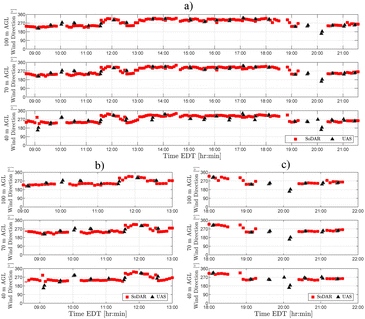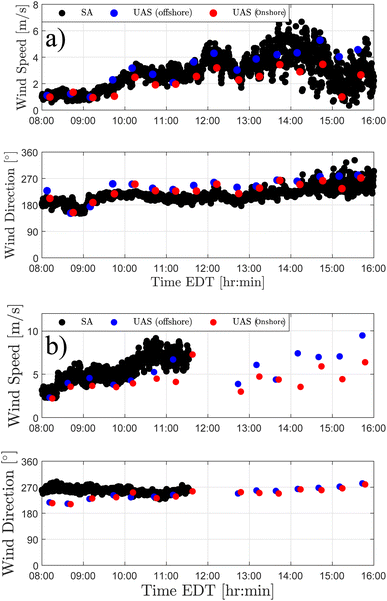 Open Access Article
Open Access ArticleCreative Commons Attribution 3.0 Unported Licence
Sensing atmospheric flows in aquatic environments using a multirotor small uncrewed aircraft system (sUAS)
Javier
González-Rocha
 *abc,
Landon
Bilyeu
b,
Shane D.
Ross
*abc,
Landon
Bilyeu
b,
Shane D.
Ross
 c,
Hosein
Foroutan
c,
Hosein
Foroutan
 d,
Stephen J.
Jacquemin
e,
Andrew P.
Ault
d,
Stephen J.
Jacquemin
e,
Andrew P.
Ault
 f and
David G.
Schmale
III
f and
David G.
Schmale
III
 b
b
aDepartment of Mechanical Engineering, University of California, Riverside, CA, USA. E-mail: javier.gonzalezrocha@ucr.edu
bSchool of Plant and Environmental Sciences, Virginia Tech, Blacksburg, VA, USA
cDepartment of Ocean and Aerospace Engineering, Virginia Tech, Blacksburg, VA, USA
dDepartment of Civil and Environmental Engineering, Virginia Tech, Blacksburg, VA, USA
eWright State University, Lake Campus, Celina, OH, USA
fDepartment of Chemistry, University of Michigan, Ann Arbor, MI, USA
First published on 3rd January 2023
Abstract
New wind sensing technologies are needed to measure atmospheric flows in aquatic environments where hazardous agents may be present and conventional atmospheric sensors are difficult to deploy. Here, we present the application of model-based multirotor sUAS (small uncrewed aircraft system) wind estimation to measure atmospheric flow variations in aquatic environments. Thirty-two sUAS flights were conducted at Grand Lake St. Marys (GLSM), Ohio in August, 2019 to characterize differences in wind profiles (wind speed and wind direction) across onshore and offshore (over the lake) locations 80 m apart. A harmful algal bloom was present in GLSM during the experiment. Fourteen calibration flights were conducted at the same site to validate multirotor sUAS wind estimates hovering next to a sonic anemometer (SA) installed 13 m above ground level. Forty-seven calibration profiles were performed in Blacksburg, Virginia on June 30th, 2020 to validate multirotor sUAS wind estimates obtained in steady ascending vertical flight next to a SoDAR wind profiler. Differences between onshore and offshore wind speed measurements at GLSM increased from morning to afternoon on each day of experiments. Flights performed next to SA and SoDAR instruments also demonstrated multirotor sUAS estimates of wind velocity components u and v to have mean absolute error values of 0.4 m s−1 and 0.3 m s−1 (hovering) and 1.2 m s−1 and 1.5 m s−1 (ascending), respectively. Overall, our findings support further development of multirotor sUAS capabilities for resolving atmospheric flows in aquatic environments.
Environmental significanceThe increased presence of harmful algal blooms in freshwater lakes, rivers, and reservoirs, as well as marine coastal areas and estuaries, poses a threat to wildlife and public health. Understanding how microscale atmospheric flows vary with space and time where land and water interface in aquatic environments is critical for characterizing the atmospheric transport of aerosolized cyanobacteria toxins produced by harmful algal blooms. Our study demonstrates that multirotor small uncrewed aircraft systems (sUAS) can reliably provide high-resolution observations of atmospheric flow variations in aquatic environments where surface heterogeneity is significant. High-fidelity measurements of atmospheric flows in aquatic environments can lead to improved atmospheric transport predictions, giving way to new possibilities for developing advisory systems that are precise, connected, and automated to reduce the number of exposure events for downwind communities. |
1 Introduction
Multirotor small uncrewed (formerly referred to unmanned) aircraft systems (sUAS) can help obtain in situ measurements of microscale (sub-1 km) atmospheric flows in aquatic environments where natural and artificial topographical features are significant. Measuring how microscale atmospheric flows evolve in complex environments has long remained a challenge due to their natural characteristics.1–3 Microscale flows vary significantly in space and time due to surface roughness and turbulence induced by shear, inertial, and buoyancy effects.4 Additionally, deploying meteorological towers, tethered balloons, as well as SoDAR and LiDAR wind profilers to measure atmospheric flow velocity is difficult and costly in complex environments.5,6 Aerial observations from crewed aircraft are also cost prohibitive and suffer from poor resolution near the Earth's surface.6 Multirotor sUAS, on the other hand, despite having a lower persistence measuring the atmosphere, are inexpensive, mobile, portable, and easy to deploy over water and hard-to-access topographies.7 Therefore, new multirotor sUAS enabled capabilities to measure wind velocity may provide reliable targeted observations for resolving microscale atmospheric flows in aquatic environments.Before multirotor sUAS were widely available, attempts to measure wind velocity, and other key atmospheric variables, with sUAS relied on fixed-wing model aircraft. Konrad et al.8 instrumented a small platform with small sensors to measure wind speed and atmospheric variables. More recent efforts to enable wind sensing with fixed-wing sUAS have lead to the development of direct and indirect methods for sampling wind velocity in the lower atmosphere. Direct methods have mostly involved integrating pitot tube and multi-hole probe air data systems on board fixed-wing sUAS for measuring wind velocity.6 Indirect methods, on the other hand, have employed fixed-wing aircraft kinematic particle, point mass, and rigid body models of varying sophistication to infer wind velocity.9–11 Elston et al.12 have developed a comprehensive review of direct and indirect techniques for measuring wind velocity with fixed-wing sUAS.
As with fixed-wing aircraft, efforts to sense wind velocity with multirotor sUAS have led to the development of direct and indirect wind sensing techniques. Numerous studies have integrated a variety of flow sensors on board multirotor sUAS to measure wind velocity while hovering at one or multiple fixed locations.5,6,13 Some of the flow sensor types considered in these studies include cup, hot-wire, and sonic anemometers;14–17 pitot tube and multi-hole probe air data systems;18 and LiDAR.19 The effectiveness of these techniques for measuring wind velocity have been found to depend on the payload capacity of the host aircraft, and the significance of measurement error produced by propeller downwash and vehicle motion. Indirect wind sensing techniques are sensor free, and instead use vehicle models, of varying sophistication, to infer wind velocity from wind-induced motion disturbances from equilibrium flight. The models that have been used to infer velocity have so far included kinematic particle, point mass, and rigid body models.4,20–22 Overall, the three models have been found to have a comparable performance measuring the prevailing wind velocity. However, studies performed by González-Rocha et al.4 have found higher-fidelity vehicle models to have an improved performance resolving time-varying wind fluctuations.
More recent work has aimed to expand the wind sensing flight envelop of multirotor sUAS beyond just hovering flight. Both direct and indirect wind sensing techniques have been leveraged to measure wind velocity in vertical steady-ascending flight. Direct approaches for profiling wind velocity have mostly involved sonic anemometers.5,6,15,23,24 Alternatively, indirect wind profiling methods have involved kinematic particle and rigid-body models. The latter wind sensing technique can be adapted for various ascent rates and could also prove useful for measuring wind fluctuations required to infer atmospheric turbulence.25–27 Rigid body models have been used to estimate wind velocity in the lower atmosphere ascending at various rates.25 Efforts to explore the feasibility of employing multirotor sUAS wind sensing capabilities for resolving atmospheric flow variations in aquatic environments are just beginning. For example, a recent study by González-Rocha et al.7 found that multirotor sUAS wind sensing capabilities can be used to characterize the drift of small and irregularly shaped objects in freshwater and saltwater environments. Bilyeu et al.28 leveraged the same wind sensing technique along with an optical particle size sensor mounted on a separate multirotor platform to monitor airborne particles over two harmful algal blooms in Grand Lake St. Marys and Lake Erie, Ohio. The two studies show that multirotor sUAS have great potential for collecting atmospheric observations in aquatic environments where conventional ground-based sensors are a challenge to deploy.
In this paper, we present the application of multirotor sUAS wind profiling for measuring spatiotemporal variations of flow velocity in complex environments where surface heterogeneity is significant. The specific objectives of our work were to: (1) use the rigid body model based wind sensing techniques developed by González-Rocha et al.4,25 to measure how the horizontal wind velocity varies with height across onshore and offshore locations 80 m apart and (2) test the reliability of multirotor sUAS wind velocity estimates flying next to a two-dimensional (2-D) sonic anemometer and a sound detection and ranging (SoDAR) wind profiler. Results from onshore and offshore measurements and calibration experiments were used to evaluate the effectiveness of multirotor sUAS model-based wind sensing techniques for resolving spatiotemporal variations of wind velocity in aquatic environments.
2 Methods and materials
2.1 Wind velocity profiling in aquatic environments
where c(*) and s(*) are abbreviations for the cosine and sine trigonometric functions, respectively. The kinematic equations are
| Ẋ = R(Θ)v + Vw(X,t) | (1) |
![[capital Theta, Greek, dot above]](https://www.rsc.org/images/entities/i_char_e161.gif) = L(Θ)ω = L(Θ)ω | (2) |
 , and v and ω are the aircraft translational and rotational velocity vectors expressed in the body-fixed reference frame,
, and v and ω are the aircraft translational and rotational velocity vectors expressed in the body-fixed reference frame,  , respectively. Additionally, the body-fixed angular velocity components are mapped to the Euler angle rates via,
, respectively. Additionally, the body-fixed angular velocity components are mapped to the Euler angle rates via,where t(*) and sc(*) are abbreviations for the tangent and secant trigonometric functions, respectively. The aircraft translational and rotational dynamic equations are
m![[v with combining dot above]](https://www.rsc.org/images/entities/i_char_0076_0307.gif) = mv × ω + fa(v) + mgRTi3 − fctrlb3 + mΦv = mv × ω + fa(v) + mgRTi3 − fctrlb3 + mΦv | (3) |
I![[small omega, Greek, dot above]](https://www.rsc.org/images/entities/i_char_e15a.gif) = Iω × ω + ma(ω,v) + mctrl = Iω × ω + ma(ω,v) + mctrl | (4) |
 the spatial wind gradient perturbing translational motion of the aircraft. Lastly, I is the moment of inertia matrix, ma is the aerodynamic moment vector, and msctrl is the control torque vector.
the spatial wind gradient perturbing translational motion of the aircraft. Lastly, I is the moment of inertia matrix, ma is the aerodynamic moment vector, and msctrl is the control torque vector.
To estimate wind velocity, the nonlinear, time-invariant rigid body model equations (i.e., (3) and (4)) are linearized about both hovering and steady-ascending equilibrium flight. The hovering equilibrium flight condition is satisfied when veq ≡ ωeq ≡ 0. The steady ascending equilibrium flight condition is satisfied when v ≡ veq, i.e., veq = 1 m s−1, and ω ≡ 0. The linear, time-invariant (LTI) models describing the aircraft dynamics about the hovering and steady ascending equilibrium flight conditions are of the form
 | (5) |
![[x with combining tilde]](https://www.rsc.org/images/entities/i_char_0078_0303.gif) = x − xeq and ũ = u − ueq denote, respectively, small deviations in the state and input vectors from their steady-state values. Additionally, the state matrix, A, models unforced dynamics, the input matrix, B, characterizes applied forcing, and the disturbance matrix, Γ, captures the translational kinematic effects of the wind disturbance vector, w = [uw,vw,ww]T. The state and input matrices that parameterize this model form were characterized using the system identification techniques developed by Morelli and Klein,30 and have been published by González-Rocha et al.25 Knowing the values of A and B, a state observer was synthesized to estimate wind velocity components uw and vw while operating in both hovering and steady-ascending equilibrium flight conditions.
= x − xeq and ũ = u − ueq denote, respectively, small deviations in the state and input vectors from their steady-state values. Additionally, the state matrix, A, models unforced dynamics, the input matrix, B, characterizes applied forcing, and the disturbance matrix, Γ, captures the translational kinematic effects of the wind disturbance vector, w = [uw,vw,ww]T. The state and input matrices that parameterize this model form were characterized using the system identification techniques developed by Morelli and Klein,30 and have been published by González-Rocha et al.25 Knowing the values of A and B, a state observer was synthesized to estimate wind velocity components uw and vw while operating in both hovering and steady-ascending equilibrium flight conditions.
 | (6) |
 in the wind-augmented model. Additionally, eqn (7) is the output equation describing the subset of state measurements collected on board the multirotor sUAS described in Section 2.1.2, which include the absolute position, orientation, and translational and rotational velocities.
in the wind-augmented model. Additionally, eqn (7) is the output equation describing the subset of state measurements collected on board the multirotor sUAS described in Section 2.1.2, which include the absolute position, orientation, and translational and rotational velocities.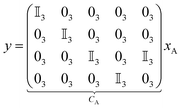 | (7) |
Finally, computing a suitable observer gain matrix GO, the state of the following observer will converge to the state of the augmented system, including the wind velocity:
 | (8) |
More details about the observer design described in eqn (8) are provided by González-Rocha et al.4,25
![[v with combining macron]](https://www.rsc.org/images/entities/i_char_0076_0304.gif) were then used to compute the average wind speed Ū and wind direction β at 10 m AGL using eqn (9) and (10), respectively.
were then used to compute the average wind speed Ū and wind direction β at 10 m AGL using eqn (9) and (10), respectively. | (9) |
 | (10) |
Wind velocity variations near the surface were then quantified as the difference between wind speed and wind direction observations measured at onshore and offshore sampling locations.
Multirotor sUAS wind velocity profiles collected at onshore and offshore sampling locations were used to quantify wind velocity variations extending from 10 to 100 m AGL. In this process, u and v wind velocity components were averaged every 10 m. The height-averaged components of wind velocity were then interpolated with respect to time and height using the bilinear interpolation function described by,
 | (11) |
The multirotor sUAS wind velocity profiles were also used to quantify wind shear differences across the land-and-water interface of the lake. In our approach, we use 10 m averaged quadrotor wind speed profiles to solve for the wind shear exponent of the power law described in eqn (12)
 | (12) |
 | (13) |
2.2 Validation of multirotor sUAS wind estimation
| Make/model [m] | Vertical range [m] | Resolution | Accuracy | ||
|---|---|---|---|---|---|
| Spatial | Temporal | Wind speed | Wind direction | ||
| Meter Atmos 22 SA | — | — | 15 s | 3% of measurement | 3% of measurement |
| Remtech PA-0 SoDAR | 200 m | 10 m | 300 s | <±0.2 m s−1 above 6 m s−1 | ±3° above 2 m s−1 |
3 Results and discussion
3.1 Validation of multirotor UAS wind estimates
| Height [m] | Samples | MAE | RMSE | ||||
|---|---|---|---|---|---|---|---|
| u [m s−1] | v [m s−1] | U [m s−1] | u [m s−1] | v [m s−1] | U [m s−1] | ||
| 13 | 577 | 0.4 | 0.3 | 0.4 | 0.5 | 0.4 | 0.6 |
| Height [m] | Samples | MAE | RMSE | ||||
|---|---|---|---|---|---|---|---|
| u [m s−1] | v [m s−1] | U [m s−1] | u [m s−1] | v [m s−1] | U [m s−1] | ||
| 40 | 40 | 1.1 | 1.6 | 2.0 | 1.6 | 2.1 | 2.6 |
| 70 | 39 | 1.2 | 1.5 | 1.9 | 1.8 | 1.8 | 2.5 |
| 100 | 39 | 1.2 | 1.5 | 1.9 | 1.8 | 1.8 | 2.5 |
| Average | 1.2 | 1.5 | 1.9 | 1.7 | 1.9 | 2.5 | |
3.2 Onshore and offshore wind velocity observations
3.3 Steady-ascending vertical flight wind observations
Wind velocity profiles collected on August 5th and 6th show that onshore and offshore wind velocity variations aloft change with respect to time and height. On both days, as shown in Fig. 9(a) and 10(a), the onshore and offshore wind speed differences measured from 10 m to 80 m AGL were found to increase significantly over time. Wind speed differences measured across onshore and offshore locations were more pronounced near the ground, where roughness length and buoyancy flow effects are most significant. Wind velocity variations associated with onshore and offshore wind direction differences were observed to be less consistent. On August 5th, notable differences were found between onshore and offshore wind direction measurements collected during the middle of the day. However, the measurements collected during this period were fewer in comparison to measurements collected during early-morning and late-afternoon hours (see Fig. 9(a)). On August 6th, as shown in Fig. 10(a), wind direction differences across onshore and offshore locations were observed to remain small with respect to time and height.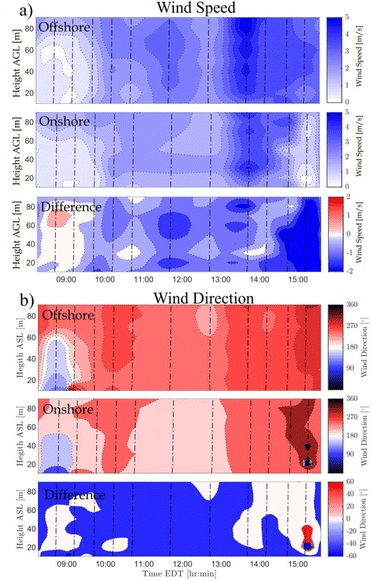 | ||
| Fig. 9 2-D contour plots showing the comparison of onshore and offshore profiles of (a) wind speed and (b) wind direction measured on August 5th. The dashed lines show the sUAS flights. | ||
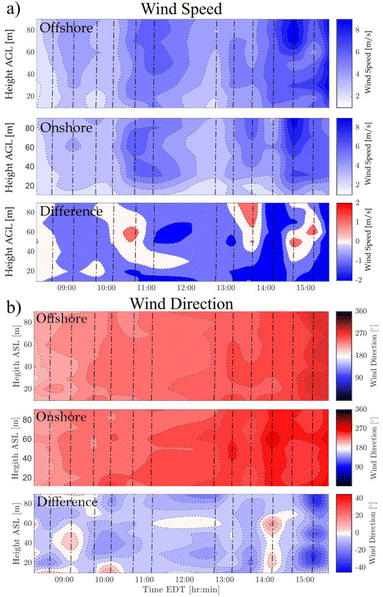 | ||
| Fig. 10 2-D contour plots showing the comparison of onshore and offshore profiles of (a) wind speed and (b) wind direction measured on August 6th. The dashed lines show the sUAS flights. | ||
Considerable wind velocity variations were also observed across onshore and offshore locations based on wind shear characterizations derived from vertical profiles collected on August 5th and 6th. As shown in Fig. 11, onshore and offshore wind shear differences grew significantly larger as wind speed increased with time on August 6th. Wind shear differences measured across onshore and offshore locations were less pronounced as wind speed increased with time to a lesser degree on August 5th. On both days, however, onshore and offshore wind shear trends were found to be largely consistent over time. These results further demonstrate the capability of multirotor sUAS wind sensing for characterizing wind velocity variations in aquatic environments.
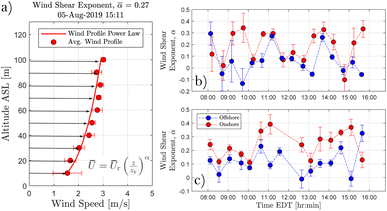 | ||
| Fig. 11 (a) A schematic showing a 10 m averaged wind profile and corresponding onshore wind shear estimate derived from the power law formulation described eqn (13). (b) A comparison plot showing how the onshore offshore wind shear exponents derived from multirotor sUAS wind profiles performed on August 5th, 2019 varied with time. (c) A comparison plot showing how the onshore offshore wind shear exponents derived from multirotor sUAS wind profiles performed on August 6th, 2019 varied with time. | ||
3.4 Discussion
Results from the multirotor sUAS wind sensing operations at Grand Lake St. Marys, Ohio revealed significant wind velocity variations at 10 m AGL between onshore and offshore sampling locations. Wind speed observations measured offshore were generally higher compared to the wind speed observations measured over water (see Fig. 8). Additionally, wind speed differences across onshore and offshore locations were observed to increase during afternoon hours as southerly (onshore) winds subsided and westerly (alongshore) winds strengthened. Wind direction observations, on the other hand, varied uniformly between onshore and offshore locations as wind direction shifted from south to west, resulting in small wind direction difference over time. Therefore, 10 m wind velocity variations observed across onshore and offshore sampling locations were characterized in large part by wind speed differences. The wind speed differences observed across onshore and offshore locations were likely driven by surface roughness length and air buoyancy effects, which are expected to be more pronounced when the wind is blowing parallel to the shoreline.The quadrotor wind velocity profiles collected at Grand Lake St. Marys also show wind variations across land and water to increase significantly from 10 to 100 m AGL as daytime evolves. Wind velocity profiles show wind speed trends to be consistent with observations measured at 10 m AGL—wind speeds were increasingly higher over water compared to land (see Fig. 9 and 10). Similarly, onshore and offshore wind velocity profiles show wind direction to vary uniformly with time. Additionally, the characterization of wind shear based on quadrotor wind velocity profiles show wind speed shear to be greater onshore. These observations are consistent with expected outcomes given that surface roughness and heat flux effects are considerably smaller over water.
Multirotor sUAS wind estimates were also found to be reliable resolving wind velocity trends based on validation experiments performed next to in situ and remote atmospheric sensors. Results from the 14 flight operations next to a sonic anemometer installed 13 m AGL showed multirotor sUAS and sonic anemometer measurements of wind speed and wind direction to track well during periods of light and moderate wind conditions. The comparison of 45 multirotor wind velocity profiles and SoDAR observations also demonstrate multirotor sUAS wind estimates to be reliable resolving wind velocity variations across space and time in both light and moderate conditions. Larger wind speed errors observed during afternoon hours are likely the result of model-based wind estimation limitations. The validity of the linear approximation described in eqn (5) may be exceeded in strong wind conditions (i.e., U > 6 m s−1). These results are consistent with previous calibration experiments performed alongside in situ remote sensing instruments.4,6,25 Therefore, multirotor sUAS wind estimates derived from both hovering and steady ascending flight operations can provide reliable observations of atmospheric flows in aquatic environments with some restrictions. Moreover, these calibration results extend the drone-based measurements presented by Bilyeu et al.28 and González-Rocha et al.7 where wind velocity estimates were obtained while hovering, and highlight the potential of drone-based wind profiles for characterizing aerosolization processes in splash zones.31
Technology improvements are also necessary to increase the effectiveness of multirotor sUAS wind sensing capabilities. Currently, the persistence of multirotor sUAS flight operations is limited by the aircraft performance envelop and battery technology, as well as the accessibility to battery charging stations. During field experiments, flight operations were constrained to a 30 minutes cadence due to having a limited number of batteries (see Fig. 8). Weather conditions also constrain the persistence of wind sensing flight operations as it is not safe to fly multirotor sUAS in rain or high wind events, both operating autonomously or with a human in the loop. For this reason, flight operations were paused during rainstorm events that took place between 11:00 and 12:30 on August 7th (see Fig. 10). Moreover, reliable wind estimates depend on accurate dynamic models. Therefore, airframe modifications performed after the completion of the LTI model characterization will likely increase the wind measurement error. Some of these constraints will become less significant as multirotor sUAS performance, battery technology, and real-time parameter estimation improves with time.
Overall, the multirotor sUAS capabilities we have presented for measuring atmospheric flow variations in aquatic environments are an important step toward understanding the atmospheric transport of hazardous agents. For instance, multirotor sUAS wind sensing capabilities paired with particle counting and water sampling technology can help characterize the aerosolization of toxic cyanobacteria produced by harmful algal blooms such as the ones found in Grand Lake St. Marys in different seasons.28,29,32–36 Moreover, vertical wind velocity and particle count information collected both hovering and steadily ascending provide new possibilities for validating atmospheric dispersion models that are used to quantify exposure to aerosol emissions. To date, atmospheric dispersion models have only been validated using near-ground observations.37–40 Lastly, the spatiotemporal resolution of wind velocity that multirotor sUAS provide is also critical for developing intelligent advisory systems that can help downwind communities rapidly and effectively detect and respond to hazardous exposure events.
4 Conclusions
In this paper, we explore the application of multirotor sUAS for characterising atmospheric flow variations across land and water in aquatic environments using a model-based wind estimation algorithm. Field study results show that microscale atmospheric flows can vary significantly over short distances where land and water interface. Additionally, experiments conducted next to in situ and remote sensing instruments demonstrate multirotor sUAS to be reliable measuring wind velocity trends both in hovering and steady ascending flight. Therefore, further development of multirotor sUAS atmospheric sensing capabilities are imperative for increasing the resolution of atmospheric observations in aquatic environments. High-fidelity meteorological measurements, along with accurate aerosol concentration counts, can improve atmospheric transport predictions. Improved atmospheric transport predictions can lead to more effective advisory systems and fewer exposure events.Author contributions
J. G. R. lead the conceptualization, data curation, formal analysis, investigation, methodology, validation, visualization, and writing of the original manuscript draft. L. B. supported data curation, investigation, and reviewing and editing the original draft. S. D. R. and H. F. contributed to the conceptualization, data curation, investigation, and reviewing and editing of manuscript draft. S. J. J. supported funding acquisition, project administration efforts, provided resources, and reviewed and edited the original manuscript draft. A. A. supported funding acquisition, project administration efforts, and reviewed and edited the original manuscript draft. D. G. S. lead funding acquisition and project administration efforts, and contributed to conceptualization, data curation, investigation, and reviewing and edition of original manuscript draft.Conflicts of interest
There are no conflicts to declare.Acknowledgements
This research was supported in part by the Institute for Critical Technology and Applied Science at Virginia Tech under grant number (ICTAS-178429).Notes and references
- K. Barskov, R. Chernyshev, V. Stepanenko, I. Repina, A. Y. Artamonov, S. Guseva and A. Gavrikov, IOP Conference Series: Earth and Environmental Science, 2017, p. 012003 Search PubMed.
- K. Barskov, V. Stepanenko, I. Repina, A. Artamonov and A. Gavrikov, Boundary-Layer Meteorology, 2019, 173, 311–320 CrossRef.
- M. Varentsov, V. Stepanenko, I. Repina, A. Artamonov, V. Bogomolov, N. Kuksova, E. Marchuk, A. Pashkin and A. Varentsov, Atmosphere, 2021, 12, 380 CrossRef.
- J. González-Rocha, C. A. Woolsey, C. Sultan and S. F. De Wekker, J. Guid. Control Dyn., 2019, 42, 836–852 CrossRef.
- P. J. Nolan, J. Pinto, J. González-Rocha, A. Jensen, C. N. Vezzi, S. C. Bailey, G. De Boer, C. Diehl, R. Laurence, C. W. Powers, H. Foroutan, S. D. Ross and D. G. Schmale III, Sensors, 2018, 18, 4448 CrossRef PubMed.
- L. Barbieri, S. T. Kral, S. C. C. Bailey, A. E. Frazier, J. D. Jacob, J. Reuder, D. Brus, P. B. Chilson, C. Crick, C. Detweiler, A. Doddi, J. Elston, H. Foroutan, J. González-Rocha, B. R. Greene, M. I. Guzman, A. L. Houston, A. Islam, O. Kemppinen, D. Lawrence, E. A. Pillar-Little, S. D. Ross, M. P. Sama, I. Schmale, G. David, T. J. Schuyler, A. Shankar, S. W. Smith, S. Waugh, C. Dixon, S. Borenstein and G. de Boer, Sensors, 2019, 19, 2179 CrossRef.
- J. González-Rocha, A. J. Sosa, R. Hanlon, A. A. Allen, I. Rypina, D. G. Schmale-III and S. D. Ross, Appl. Ocean Res., 2021, 110, 102538 CrossRef.
- T. G. Konrad, M. L. Hill, J. R. Rowland and J. H. Meyer, Johns Hopkins APL Tech. Dig., 1970, 10, 11–21 Search PubMed.
- J. W. Langelaan, N. Alley and J. Neidhoefer, J. Guid. Control Dyn., 2011, 34, 1016–1030 CrossRef.
- P. J. Nolan, H. G. McClelland, C. A. Woolsey and S. D. Ross, Sensors, 2019, 19, 1607 CrossRef.
- H. G. McClelland and C. A. Woolsey, J. Guid. Control Dyn., 2020, 43, 1069–1081 CrossRef.
- J. Elston, B. Argrow, M. Stachura, D. Weibel, D. Lawrence and D. Pope, J. Atmos. Ocean. Technol., 2015, 32, 97–115 Search PubMed.
- P. Abichandani, D. Lobo, G. Ford, D. Bucci and M. Kam, IEEE Access, 2020, 8, 54910–54927 Search PubMed.
- C. A. Wolf, R. P. Hardis, S. D. Woodrum, R. S. Galan, H. S. Wichelt, M. C. Metzger, N. Bezzo, G. C. Lewin and S. F. de Wekker, 2017 Systems and Information Engineering Design Symposium (SIEDS), 2017, pp. 32–37 Search PubMed.
- T. Shimura, M. Inoue, H. Tsujimoto, K. Sasaki and M. Iguchi, J. Atmos. Ocean. Technol., 2018, 35, 1621–1631 Search PubMed.
- G. W. Donnell, J. A. Feight, N. Lannan and J. D. Jacob, 2018 Atmospheric Flight Mechanics Conference, 2018, p. 2986 Search PubMed.
- C. Ingenhorst, G. Jacobs, L. Stößel, R. Schelenz and B. Juretzki, Wind Energy Sci., 2021, 6, 427–440 CrossRef.
- S. Prudden, A. Fisher, M. Marino, A. Mohamed, S. Watkins and G. Wild, J. Wind Eng. Ind. Aerodyn., 2018, 176, 197–210 CrossRef.
- N. Vasiljević, M. Harris, A. Tegtmeier Pedersen, G. Rolighed Thorsen, M. Pitter, J. Harris, K. Bajpai and M. Courtney, Atmos. Meas. Tech., 2020, 13, 521–536 CrossRef.
- P. P. Neumann and M. Bartholmai, Sens. Actuators, A, 2015, 235, 300–310 CrossRef CAS.
- C. Brosy, K. Krampf, M. Zeeman, B. Wolf, W. Junkermann, K. Schäfer, S. Emeis and H. Kunstmann, Atmos. Meas. Tech., 2017, 10, 2773–2784 CrossRef.
- R. T. Palomaki, N. T. Rose, M. van den Bossche, T. J. Sherman and S. F. De Wekker, J. Atmos. Ocean. Technol., 2017, 34, 1183–1191 Search PubMed.
- T. M. Bell, B. R. Greene, P. M. Klein, M. Carney and P. B. Chilson, Atmos. Meas. Tech., 2020, 13, 3855–3872 CrossRef.
- M. J. Brewer and C. B. Clements, Fire, 2020, 3, 36 CrossRef.
- J. González-Rocha, S. F. De Wekker, S. D. Ross and C. A. Woolsey, Sensors, 2020, 20, 1341 CrossRef.
- A. Shelekhov, A. Afanasiev, E. Shelekhova, A. Kobzev, A. Tel'minov, A. Molchunov and O. Poplevina, Drones, 2022, 6, 1–22 CrossRef.
- S. A. Bollt and G. P. Bewley, J. Fluid Mech., 2021, 921, A18 CrossRef CAS.
- L. Bilyeu, B. Bloomfield, R. Hanlon, J. González-Rocha, S. J. Jacquemin, A. Ault, J. Birbeck, J. Westrick, H. Froutan, L. Marr, S. Ross, C. Powers and D. G. Schmale III, Environ. Sci.: Atmos., 2022, 1351 Search PubMed.
- R. Hanlon, S. J. Jacquemin, J. A. Birbeck, J. A. Westrick, C. Harb, H. Gruszewski, A. P. Ault, D. T. Scott, H. Foroutan, S. D. Ross, J. Gonzaĺez-Rocha, C. Powers, L. Pratt, H. Looney, G. Baker and D. G. Schmale III, Frontiers in Remote Sensing, 2022, 949052 CrossRef.
- E. A. Morelli and V. Klein, Aircraft System Identification: Theory and Practice, Sunflyte Enterprises, Williamsburg, Virginia, 2016 Search PubMed.
- R. B. Pietsch, H. Grothe, R. Hanlon, C. W. Powers, S. Jung, S. D. Ross and D. G. Schmale III, PeerJ, 2018, 6, e5663 CrossRef PubMed.
- D. G. Schmale III, A. P. Ault, W. Saad, D. T. Scott and J. A. Westrick, Front. Bioeng. Biotechnol., 2019, 7, 128 CrossRef.
- N. E. Olson, M. E. Cooke, J. H. Shi, J. A. Birbeck, J. A. Westrick and A. P. Ault, Environ. Sci. Technol., 2020, 54, 4769–4780 CrossRef CAS.
- N. E. Olson, N. W. May, R. M. Kirpes, A. E. Watson, K. D. Hajny, J. H. Slade, P. B. Shepson, B. H. Stirm, K. A. Pratt and A. P. Ault, ACS Earth Space Chem., 2019, 3, 2765–2774 CrossRef CAS.
- H. E. Plaas and H. W. Paerl, Environ. Sci. Technol., 2020, 55, 44–64 CrossRef PubMed.
- S. D. Ross, J. Fish, K. Moeltner, E. M. Bollt, L. Bilyeu and T. Fanara, Harmful Algae, 2022, 111, 102149 CrossRef CAS.
- D. E. Aylor and T. K. Flesch, J. Appl. Meteorol. Climatol., 2001, 40, 1196–1208 CrossRef.
- N. S. Holmes and L. Morawska, Atmos. Environ., 2006, 40, 5902–5928 CrossRef CAS.
- R. R. Thiruvenkatachari, V. Carranza, F. Ahangar, A. Marklein, F. Hopkins and A. Venkatram, Agric. For. Meteorol., 2020, 290, 108011 CrossRef.
- R. R. Thiruvenkatachari, Y. Ding, D. Pankratz and A. Venkatram, Air Qual., Atmos. Health, 2022, 15, 363–372 CrossRef CAS.
| This journal is © The Royal Society of Chemistry 2023 |

